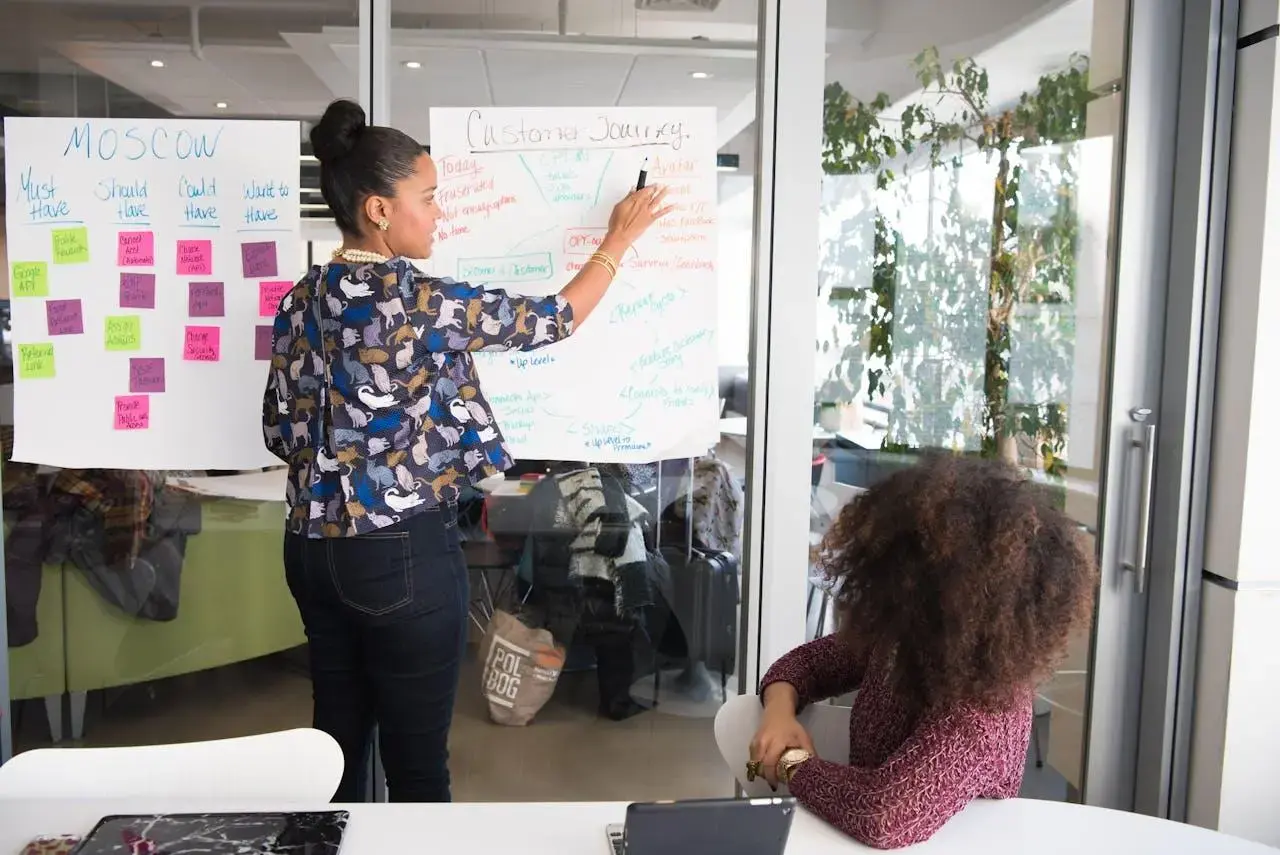Commit yourself to lifelong learning. The most valuable asset you'll ever have is your mind and what you put into it.
Albert Einstein
To learn throughout your life, you first need to know how to learn.
Because knowing how to learn is a skill in itself. It relies on several factors:
- knowing how you work,
- structuring your revision,
- using the right tools
- and creating an environment conducive to learning.
In this article, we give you concrete methods and practical tools to learn better and more sustainably. To find which tools work best for you, take our quiz on learning styles.
Keep in mind that it takes an average of 66 days to form a habit (Lally, van Jaarsveld, Potts, and Wardle1). Ready to take on the challenge?


Method n°1: Identify Your Memory Type to Learn Better
The first thing to do is to understand how you work in order to facilitate your learning.
The Different Types of Learning According to John Burville Biggs
John Burville Biggs, an Australian psychologist specializing in knowledge acquisition, studied and categorized different types of learning. He wrote a book on the subject in collaboration with Ross Telfer.5
Surface learning involves memorizing facts such as dates, names, vocabulary, and events.
This first level of learning is an important part of any review session before a test or exam.
Deep learning, on the other hand, involves understanding the underlying mechanisms of a subject. It usually goes hand in hand with a genuine interest in the subject matter and gives meaning to what we learn.
It involves finding patterns, making connections, and applying a similar model to various learning experiences.
Performative learning is similar to deep learning, as it also allows connections to be made and trends to be identified.
However, rather than stemming from personal interest and curiosity, the motivation behind this type of learning comes from a desire to succeed in an assignment. According to Anderson, this type of learning requires students to understand, not just memorize.6
Deep learning and performance learning are therefore similar in that they involve comprehension skills in addition to memorisation skills.
Deep learning is generally more fundamental, as the student demonstrates a genuine interest in the subject. Their curiosity about the subject promotes both motivation and learning.
We are all different and have different ways of learning and different techniques.
Deep learning promotes motivation and facilitates information retention
when individual learning styles are taken into account.
In her study, Doris B. Matthews demonstrates the importance of learning styles, particularly for first-year students.15 Knowledge and information are processed by our senses, which is why we prefer to learn using those that are most dominant in us.
The 4 Learning Styles According to the VARK Model
The VARK model is a popular method for understanding individual learning styles. It was developed by Neil Fleming in the 1990s and is based on the idea that everyone learns more effectively according to certain sensory preferences.
VARK is an acronym that refers to four learning styles:
V for Visual
You retain information better when it is presented in graphic or schematic form:
- Diagrams
- Mind maps
- Tables, graphs
- Colours and structured layout
You prefer to see the relationships between ideas rather than read long paragraphs.
A for Auditory
You prefer to listen:
- Oral explanations
- Discussions
- Podcasts
- Audio recordings
- Face-to-face lessons or explanatory videos
You retain well what you hear and learn through conversation or stories.
R for Reading and Writing
You are comfortable with the written word:
- Taking notes
- Reading manuals, articles, or documents
- Writing summaries
- Searching databases or dictionaries
You enjoy reading and writing to better absorb information.
K for Kinesthetic
Experimenting:
- Case studies
- Role-playing
- Practical workshops
- Real-life experiences
- Simulations
You retain information better when you are active and physically involved.
The VARK Model, Superprof Style
The three most common styles are visual learning, auditory learning, and kinesthetic (tactile) learning. This is because learning through reading can be likened to visual learning, and learning through writing to kinesthetic learning.
Each type is represented by a character and a colour to help you find your way around the tools we offer.
- The photographer, associated with the colour blue, represents visual learning (seeing).
- The musician, associated with the colour pink, represents auditory learning (hearing).
- The explorer, associated with the colour green, represents kinesthetic or tactile learning (doing).
Howard Gardner describes learning styles as the different ways in which students approach learning materials and schoolwork.7 Different types of intelligence and different styles have an impact on how students best retain information.
The Photographer 🦋

For photographers, knowledge is best absorbed through visual perception.
Fortunately for this group, most school activities focus on this type of learning. Photographers retain information well by reading texts and taking notes. Making flashcards, diagrams, and using colour coding are all techniques that can help them improve their learning ability.
Photographers will be able to make full use of different visual cues to highlight aspects of a subject. The information can then be retrieved in the form of a mental image that they can access whenever they need it.
In this article, the photographer is represented by the colour blue and the emoji 🦋.
The tools we mention to help you on your learning journey are colour-coded. Photographers will be able to identify what suits them best by looking for the colour blue.
👩🏻🎤 The Musician
Hearing is the dominant sense for musicians. It allows them to retain information. For this reason, they learn best by attending classes.
People in this group tend to remember more of what they hear during a class or in a discussion with classmates than what they read.
Musicians often listen to music while they study, as it helps them stay focused. An audio aid will enable musicians to understand and retain information more quickly.

In this article, musicians are represented by the colour pink and the emoji 👩🎤.
Musicians: identify the tools in this colour, they will help you learn better.
The Explorer 🐍
The explorer’s dominant learning style can be called tactile or kinesthetic. Their ideal way is to learn by doing.

They tend to prefer more practical ways of learning, such as lab assignments or study visits. The explorer can be extra quick at learning sports or how to play music.
If you are an explorer, there are several ways to implement movement and tactile learning into academic life.
Howard Gardner introduced the concept of intelligence types and the idea that we all learn in different ways. He calls this type of intelligence “bodily-kinesthetic intelligence” and shows how it works.7
Rather than consulting notes, explorers prefer to write them down or even experience them. If you study art history, for example, you will be drawn to museums. As an explorer, experiences are part of your learning.
In this article, learning tools suitable for explorers are represented by the colour green and the emoji 🐍.
Prithishkumar, I. J., & Michael, S. A. established in their article
“Understanding Your Student: using the VARK model” published in the Journal of Postgraduate Medicine that the majority of students implement a multimodal learning strategy, as combining different learning styles leads to better results.11 This means that you can have a primary learning style that works perfectly with a secondary style.
What Are Some Other Learning Models?
There are other learning styles besides the VARK model.
The Kolb model13 is a theory of experiential learning developed by David Kolb in the 1980s. It is based on the idea that learning occurs through experience, in a four-step cycle:
- Concrete experience (experiencing a situation)
- Reflective observation (analysing what happened)
- Abstract conceptualisation (deriving principles or ideas)
- Active experimentation (testing these ideas in new situations)
Based on this cycle, Kolb identified four main learner profiles, according to each person's preferences in this process.
The Convergent
A mix of active experimentation and abstract conceptualisation
- Characteristics: practical, solution-oriented, logical, enjoys solving technical or concrete problems
- Strengths: applying ideas in a concrete way, getting to the heart of the matter, finding “the right answer”
- Learning style: prefers situations where they can test a theory or find a clear solution. Very comfortable with science, technology, and models.
The Divergent
A blend of practical experience and thoughtful observation
- Characteristics: imaginative, sensitive, open to emotions and multiple perspectives
- Strengths: sees situations from multiple angles, generates ideas, makes connections between experiences
- Learning style: learns best through observation, stories, and discussions. Appreciated in artistic, social, or helping professions.
The Assimilator
A blend of thoughtful observation and abstract conceptualisation
- Characteristics: analytical, rigorous, likes to understand concepts and theories
- Strengths: structuring information, organising ideas, understanding a subject in depth
- Learning style: prefers logical models, reading, and lectures. Learns best when able to analyse, classify, and understand before acting.
The Accommodator
A mix of practical experience and active experimentation
- Characteristics: intuitive, spontaneous, likes to take action quickly and learn by trial and error
- Strengths: reacts effectively in action, adapts, takes initiative
- Learning style: prefers to experiment, do, and discover through practice. Learns best in dynamic and concrete environments.
To get to know yourself better, you can also take a personality test such as Jung or the MBTI test. You may be surprised by the results!
Knowing yourself well allows you to identify the learning methods that suit you best.
Method n°2: Take Notes to Structure and Memorise
No matter what your learning style is, taking notes will have a beneficial effect on you.
- If you are visual 🦋, you will learn more easily with structured, organised texts, ideas highlighted with colours...
- If you are more auditory 👩🎤, writing or drawing during class will help you stay focused on what the teacher is saying.
- If you are kinesthetic 🐍, drawing or writing will help you anchor what you learn in your memory.

Don't just rely on the teaching materials provided by your teachers. While they are an additional aid that will help you organise yourself, keep in mind that you will still need to review and summarise the information.
This is what will enable you to truly memorise what you have just learned. So, whether you use materials or not, rephrasing the information you have just obtained will allow you to focus on the most important points, be precise, establish priorities, and organise your thoughts.
This exercise will allow you to become more involved in your learning than when you read a text or listen to a teacher. Note-taking allows all types of learners to assimilate information in an organised way, even if it is not their preferred learning style.14
You can use paper for note-taking or apps to take notes and organise them, such as Evernote, Obsidian, and Simplenote.
Method n°3: Adopt the Right Learning Techniques
To effectively counteract this "forgetting curve," it is recommended that you read the notes you took on the same day, then on the second and third days.
Chun and Heo, 2018 (2)
According to Finkenbinder's study, the best time to study is in the morning around 8 a.m.
In the morning around 8:00 a.m. is the best time to study.
These techniques will help you memorise information better, which will save you from sleepless nights before exams. We've all spent a sleepless night studying, and it will probably happen to you from time to time. But now you know how to avoid it.
Spaced Repetition 🦋 👩🎤 🐍
The usefulness of spaced repetition was theorised in the late 19th century by German psychologist Hermann Ebbinghaus12. He is famous for his experimental studies of memory and forgetting, and for establishing what is known as the forgetting curve.
Ebbinghaus showed that without revision, we forget much of the information we learn within hours or days. Memory declines exponentially... unless we regularly reactivate the information.
Spaced repetition is based on the fact that our brains retain information better when they have to make an effort to recall it after a certain amount of time, rather than reviewing information intensively in a single session (bye bye to all-nighters).
By reviewing at strategic intervals (just before you forget), you actively stimulate the consolidation of information into long-term memory.
Tools such as Anki and Quizlet incorporate this principle in an automated way: they adjust the frequency of review according to how easily the user remembers a piece of information. The result is more efficient, long-lasting, and personalised learning, ideal for students, professionals, or anyone who wants to memorise information for the long term.
You can also do this without an app. Although there is no universal time frame, cognitive psychology research and spaced repetition algorithms generally recommend the following schedule, adjusted according to recall performance:
[table “us_101367” not found /]Mind Maps 🦋 🐍
Mind maps, also known as mind maps, are visual tools for organising ideas based on a tree structure.
You start with a key word or concept in the centre of the page, then develop branches around it, each representing an associated idea or theme. These branches can be subdivided into sub-branches, allowing you to structure information in a logical, hierarchical, and visually clear way.
Using colours, pictograms, or keywords further enhances memorisation. Mind maps are particularly useful for taking notes, planning a project, reviewing a lesson, or stimulating creativity by promoting a comprehensive and intuitive view of a subject.
Mind maps are based on several cognitive theories that explain their effectiveness, particularly in the areas of learning, memory, and creativity:
The Dual Coding Theory (Paivio, 1971)
According to Allan Paivio, our brain processes information via two complementary channels:
- The verbal channel (text, words)
- The visual channel (images, diagrams)
Mind maps exploit these two systems by combining keywords and graphic elements, which promotes better memorisation.
Cognitive Load (Sweller, 1988)
John Sweller explains that our working memory is limited, and that an excess of poorly structured information hinders learning.
Mind maps help to reduce cognitive load by organising information visually in a clear and hierarchical manner.18
Meaningful Learning (Ausubel, 1963)
David Ausubel argues that learning is more effective when it is organised around concepts that already exist in the learner's mind.
Mind maps facilitate this structuring by linking new information to central or already known ideas.19
Radiant Thinking (Tony Buzan)
Tony Buzan, creator of the concept of mind mapping, describes mind maps as an expression of radiant thinking, i.e. our natural ability to freely associate ideas around a central theme, in the same way as neural connections.20

Flashcards 🦋 👩🎤 🐍
Flashcards are double-sided cards used for learning. On one side, there is a question, a keyword, or a definition to be completed, and on the other side, the answer.
Their effectiveness is based on a simple but powerful mechanism: active self-questioning.
Rather than passively rereading notes21, you test yourself by asking questions, which stimulates retrieval practice22, a fundamental lever of long-term memorisation (and you don't need anyone else to do it).
Flashcards can be made by hand or using apps such as Anki, Quizlet, or Brainscape, often combined with the principle of spaced repetition to maximise knowledge retention.

Method n°4: Plan and Organise Your Study Sessions
To learn effectively, it is not enough to simply accumulate hours of work: you also need to know how to structure your time, manage your priorities, and stay focused.
Among the most widely used methods, the Pomodoro technique involves alternating 25-minute work periods with short breaks to maintain a good level of attention.
We say 25 minutes because several theories have determined that this is the ideal concentration span for optimal learning.

The attention plateau effect is a theory showing that our sustained attention tends to decrease after 20 to 30 minutes, reducing our performance.23 The brain can only process a limited amount of information at a time. Sessions that are too long generate cognitive overload, which hinders learning. 25-minute sessions allow you to stay in an optimal zone between effort and assimilation without mental saturation.18
Parkinson's law24 states that “work expands so as to fill the time available for its completion.” By setting a short deadline (25 minutes), we create healthy time pressure that encourages concentration and avoids procrastination.
Finally, alternating short bursts of effort with short breaks creates a motivating rhythm, with a system of immediate reward (the break). This reinforces commitment to the task and a sense of accomplishment. This cycle of effort and reward is based on the brain's dopamine mechanisms linked to extrinsic motivation.25
Other strategies such as smart to-do lists (which prioritise tasks according to their importance or the energy required to complete them) or blocking digital distractions can help create an environment conducive to deep learning.
Several apps can help you implement these techniques: Itsycal to visualise your schedule at a glance, Forest to stay focused by gamifying your time, or Touchbartimer to time your work sessions. These tools are detailed in our article on organisation.
Method #5: Sleep well to consolidate learning
Good learning doesn't just happen in front of your notes or screen: it continues while you sleep.
It is during the deep sleep phases that the brain consolidates the information learned during the day, transferring it from short-term memory to long-term memory.
Conversely, sleepless nights or fragmented sleep disrupt this process, reducing concentration and impairing knowledge retention.9

To promote quality sleep, it is essential to prepare your mind for rest by establishing a soothing end-of-day ritual.
Apps such as Balance, Calm, and Headspace can help you disconnect mentally with breathing exercises, meditation, and relaxing stories. Good, regular, restful sleep is one of the best allies for a strong memory.
Here is our short list of recommendations for a good night's sleep:
- Be consistent: go to bed at the same time (more or less) and wake up at the same time, even on weekends. Your brain will love you for it!
- Dim the lights about an hour before going to bed to prepare your body and brain for sleep.
- Don't look at any screens for at least an hour before going to bed.
- Don't stay in bed for long periods of time if you are awake, so that you don't associate your bed with stress because you can't sleep.10
Method n°6: Maintain Motivation and Focus
Our working memory is a powerful but limited system: according to Miller's law, it can only hold 5 to 9 items at a time, and only for a few seconds.26
The duration of immediate memory appears to be approximately seven for numbers, approximately six for letters, and approximately five for words.
George A. Miller, 1956
This theory has been widely confirmed and refined since then, particularly by research on working memory (Baddeley & Hitch).
When this memory is overloaded with too much information at once, we enter a state of cognitive overload: the brain is no longer able to encode data correctly into long-term memory. Attention then becomes scattered, focus on key concepts diminishes, and knowledge retention is significantly reduced. This mental overload can even lead to disengagement, because if you feel overwhelmed, you often end up becoming demotivated.
However, in education, motivation plays a central role in learning. There are two main types:
- Intrinsic motivation, which comes from within: you act out of interest, pleasure, or curiosity about the subject. This is the most lasting and engaging form.
- Extrinsic motivation, which is based on external factors: getting a grade, earning a degree, avoiding failure, or receiving a reward.
To stay motivated and focused over time, several simple tips can make a difference:
- Set concrete and achievable goals (for example: “review this chapter in 45 minutes”).
- Use the Pomodoro technique to break your work into short sessions
- Turn off notifications on your phone or computer to avoid interruptions
- Take active breaks: walk, stretch, breathe deeply
Effective learning therefore also means knowing how to respect your cognitive limits while nurturing your personal motivation.
Conclusion
Albert Einstein was right: your brain is your most valuable asset. But to use it well, it is essential to optimise its functioning and develop good learning habits.
Knowing yourself well and identifying the tools that work for you, learning how to learn effectively, sleeping well, and staying organised are all essential elements for your academic success and your future.
Feel free to try out several approaches to develop THE method that works for you. So which method are you going to try? Let us know in the comments!
Sources
- Lally, P., van Jaarsveld, C., Potts, H. and Wardle, J., 2009. How are habits formed: Modelling habit formation in the real world. European Journal of Social Psychology , [online] 40(6), pp.998-1009. Available at: <http://repositorio.ispa.pt/bitstream/10400.12/3364/1/IJSP_998-1009.pdf> [Accessed 17 August 2022].
- Chun, B. and Heo, H., 2018. The effect of flipped learning on academic performance as an innovative method for overcoming Ebbinghaus' forgetting curve. Proceedings of the 6th International Conference on Information and Education Technology, [online] Available at: <https://dl.acm.org/doi/pdf/10.1145/3178158.3178206> [Accessed 17 August 2022].
- Walker, M., 2008. Sleep-Dependent Memory Processing. Harvard Review of Psychiatry , [online] 16(5), pp.287-298. Available at: <https://journals.lww.com/hrpjournal/Abstract/2008/09000/Sleep_Dependent_Memory_Processing.3.aspx> [Accessed 17 August 2022].
- Quirion Hutter, A., 2022. A Study of Visual Notetaking and College-Age Learners . PHD. Lamar University.
- Biggs, John B. & Telfer, Ross. 1987, The process of learning / John B. Biggs, Ross Telfer Prentice-Hall of Australia Sydney
- Anderson, M., 2018. Kevin Michael Klipfel and Dani Brecher Cook. Learner-Centered Pedagogy: Principles and Practice. Chicago, Ill.: ALA Editions, 2017. 208p. Paper, $60.00 (ISBN 978-0-8389-1557-8). LC 2016058814. College & Research Libraries , [online] 79(7), pp.998-1000. Available at: <https://crl.acrl.org/index.php/crl/article/view/17414> [Accessed 17 August 2022].
- GARDNER, H. (1983). Frames of mind: the theory of multiple intelligences. New York, Basic Books.
- Gambill, J., Moss, L. and Vescogni, C., 2008. The Impact of Study Skills and Organisational Methods on Student Achievement . Master. Saint Xavier University., Available at: <https://files.eric.ed.gov/fulltext/ED501312.pdf> [Accessed 17 August 2022]
- Guadiana, N. and Okashima, T., 2020. The Effects of Sleep Deprivation on College Students . Senior. Dominican University of California. [online] Available at: <https://link.springer.com/article/10.1007/BF00992891> [Accessed 17 August 2022].
- Dr. Matt Walker, 2022. Optimising your Sleep . [podcast] The Matt Walker Podcast. Available at: <https://themattwalkerpodcast.buzzsprout.com/1821163/10897112-25-optimising-your-sleep> [Accessed 17 August 2022].
- Prithishkumar, I. and Michael, S., 2014. Understanding your student: Using the VARK model. Journal of Postgraduate Medicine , [online] 60(2), p.183. Available at: <https://pubmed.ncbi.nlm.nih.gov/24823519/> [Accessed 17 August 2022].
- Ebbinghaus, H., 1885. A Contribution to Experimental Psychology . University of Berlin.
- David A. Kolb (1984), Experiential Learning: Experience as the Source of Learning and Development.
- Piolat, A., Olive, T. and Kellogg, R., 2005. Cognitive effort during note taking. Applied Cognitive Psychology , [online] 19(3), pp.291-312. Available at: <https://www.researchgate.net/publication/234117782_Cognitive_effort_during_note_taking> [Accessed 17 August 2022].
- Matthews, D., 1991. The effects of learning style on grades of first-year college students. Research in Higher Education , [online] 32(3), pp.253-268. Available at: <https://link.springer.com/article/10.1007/BF00992891> [Accessed 17 August 2022].
- Finkenbinder, E., 1913. The Curve of Forgetting. The American Journal of Psychology , [online] 24(1), p.8. Available at: <https://www.jstor.org/stable/pdf/1413271.pdf> [Accessed 17 August 2022].
- Paivio, A. (1971). Imagery and Verbal Processes.
- Sweller, J. (1988). Cognitive Load During Problem Solving: Effects on Learning. Cognitive Science.
- Ausubel, D. P. (1963). The Psychology of Meaningful Verbal Learning.
- Buzan, T. (1993). The Mind Map Book.
- Roediger, H. L., & Karpicke, J. D. (2006). Test-enhanced learning: Taking memory tests improves long-term retention. Psychological Science.
- Roediger, H. L., & Butler, A. C. (2011). The critical role of retrieval practice in long-term retention. Trends in Cognitive Sciences.
- Warm, J. S., Parasuraman, R., & Matthews, G. (2008). Vigilance requires hard mental work and is stressful. Human Factors.
- Parkinson, C. N. (1955). Parkinson’s Law, or the Pursuit of Progress.
- Aarts, H., Custers, R., & Marien, H. (2008). Preparing and motivating behavior outside of awareness. Science.
- George A. Miller (1956), “The Magical Number Seven, Plus or Minus Two: Some Limits on Our Capacity for Processing Information”, Psychological Review.
Your tutor is waiting for you on Superprof!
Want to give it a try?
Let our experts impress you!













Excellent article!
Really interesting! Thank you so much for sharing such a good content :)
Great article. And the quiz was spot on!!
What an interesting article in order further optimize the learning ability! Full of information, facts and recommendations. The quiz is absolutely accurate!